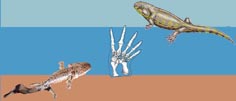Stratigraphical Framework
A new 500m deep cored borehole through the Ballagan Formation is providing a key spatial and temporal framework to establish the evolutionary sequence of the organisms and the timeframe in which recovery from the end-Devonian extinction event occurred.
We use a number of stratigraphic tools to examine the borehole sedimentary rocks: palynology and ostracod biostratigraphy (see Palynological Framework), lithostratigraphy (see Sedimentological Framework), sequence stratigraphy, wireline correlations and chemo-stratigraphy (see Isotopic Framework). This enables us to understand how the sedimentary and climate systems changed with time.
We are integrating the tetrapod data into this comprehensive framework, providing correlations across the wider Scottish Midland Valley, enabling us to create robust models for understanding the ecosystems.
Comparison of the new core data with the continuous continental section through the Devonian-Carboniferous boundary of East Greenland will tell us if there are condensed sections or breaks (resulting from erosion or non-deposition) in the Ballagan Formation in Scotland. These two far-field records will be compared with the results of a study of climate change around the time of the Devonian-Carboniferous boundary currently being carried out in high palaeolatitudes of Bolivia.


